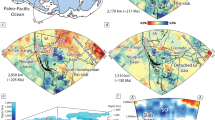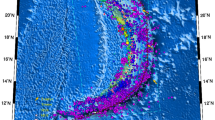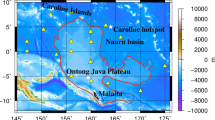Abstract
Recent results from seismic tomography demonstrate that subducted oceanic lithosphere can be observed globally as slabs of relatively high seismic velocity in the upper as well as lower mantle1,2. The Asian mantle is no exception, with high-velocity slabs being observed downwards from the west Pacific subduction zones under the Kurile Islands, Japan and farther south3,4,5, as well as under Asia's ancient Tethyan margin. Here we present evidence for the presence of slab remnants of Jurassic age that were subducted when the Mongol–Okhotsk and Kular–Nera oceans closed between Siberia, the combined Mongolia–North China blocks and the Omolon block6,7,8. We identify these proposed slab remnants in the lower mantle west of Lake Baikal down to depths of at least 2,500 km, where they join what has been interpreted as a ‘graveyard’9 of subducted lithosphere at the bottom of the mantle. Our interpretation implies that slab remnants in the mantle can still be recognized some 150 million years or more after they have been subducted and that such structures may be useful in associating geodynamic to surface-tectonic processes.
This is a preview of subscription content, access via your institution
Access options
Subscribe to this journal
Receive 51 print issues and online access
$199.00 per year
only $3.90 per issue
Buy this article
- Purchase on Springer Link
- Instant access to full article PDF
Prices may be subject to local taxes which are calculated during checkout




Similar content being viewed by others
References
van der Hilst, R. D., Widiyantoro, S. & Engdahl, E. R. Evidence for deep-mantle circulation from global tomography. Nature 386, 578–584 (1997).
Grand, S., van der Hilst, R. D. & Widiyantoro, S. Global seismic tomography: A snapshot of convection in the Earth. GSA today 7, 1–7 (1997).
van der Hilst, R., Engdahl, R., Spakman, W. & Nolet, G. Tomographic imaging of subducted lithosphere below the northwest Pacific island arcs. Nature 353, 37–43 (1991).
Richards, M. A. & Engebretson, D. C. Large-scale mantle convection and the history of subduction. Nature 355, 437–440 (1992).
Wen, L. & Anderson, D. L. The fate of slabs inferred from seismic tomography and 130 million years of subduction. Earth Planet. Sci. Lett. 133, 185–198 (1995).
Şengör, A. M. C. & Natal'in, B. A. in The Tectonic Evolution of Asia(eds Yin, A. & Harrison, M.) 486–640 (Cambridge Univ. Press, (1996)).
Zhao, X. X., Coe, R. S., Zhou, Y., Wu, H. & Wang, J. New paleomagnetic results from northern China: Collision and suturing with Siberia and Kazakhstan. Tectonophysics 181, 43–81 (1990).
Enkin, R., Yang, Z. Y., Chen, Y. & Courtillot, V. Paleomagnetic constraints on the geodynamic history of the major blocks of China from the Permian to the Present. J. Geophys. Res. 97, 13953–13989 (1992).
Wysession, M. E. in Subduction(eds Bebout, G. et al.) 369–384 (Monogr. 96, Am. Geophys. Union, Washington DC, (1996)).
Yin, A. & Nie, S. Y. in The Tectonic Evolution of Asia(eds Yin, A. & Harrison, M.) 442–485 (Cambridge Univ. Press, (1996)).
Gilder, S. & Courtillot, V. Timing of the North-South China collision from new middle to late Mesozoic paleomagnetic data from the North China block. J. Geophys. Res. 102, 17713–17727 (1997).
Ziegler, A. M. et al. in The Tectonic Evolution of Asia(eds Yin, A. & Harrison, M.) 371–400 (Cambridge Univ. Press, (1996)).
Parfenov, L. M. Tectonics of the Verkhoyansk-Kolyma Mesozoides in the context of plate tectonics. Tectonophysics 199, 319–342 (1991).
Bijwaard, H., Spakman, W. & Engdahl, R. Closing the gap between regional and global travel time tomography. J. Geophys. Res. 103, 30055–30078 (1998).
Dziewonski, A. M., Hager, B. H. & O'Connell, R. J. Large-scale heterogeneities in the lower mantle. J. Geophys. Res. 82, 239–255 (1977).
Zhou, H. Ahigh resolution P-wave model for the top 1200 km of the mantle. J. Geophys. Res. 101, 27791–27810 (1996).
Engdahl, E. R., van der Hilst, R. D. & Buland, R. P. Global teleseismic earthquake relocation with improved travel times and procedures for depth determination. Bull. Seismol. Soc. Am. 88, 722–743 (1998).
Spakman, W. & Bijwaard, H. Irregular cell parameterization of tomographic problems. Ann. Geophys. 16 (suppl. 1), 28 (1998).
Curtis, C., Dost, B., Trampert, J. & Snieder, R. Eurasian fundamental mode surface wave phase velocities and their relationship with tectonic structures. J. Geophys. Res.(in the press).
Ritzwoller, M. H. & Levshin, A. L. Eurasian surface wave tomography: Group velocities. J. Geophys. Res. 103, 4839–4878 (1998).
Cande, S. C., Raymond, C. A., Stock, J. & Haxby, W. F. Geophysics of the Pitman Fracture Zone and Pacific-Antarctic plate motions during the Cenozoic. Science 270, 947–953 (1995).
Tarduno, J. A. & Cottrell, R. D. Paleomagnetic evidence for motion of the Hawaiian hotspot during formation of the Emperor Seamounts. Earth Planet. Sci. Lett. 153, 171–180 (1997).
Ricard, Y., Richards, M. A., Lithgow-Bertelloni, C. & Le Stunff, Y. Ageodynamic model of mantle density heterogeneity. J. Geophys. Res. 98, 21895–21909 (1993).
Lithgow-Bertelloni, C. & Richards, M. A. The dynamics of Cenozoic and Mesozoic plate motions. Rev. Geophysics 36, 27–78 (1998).
Scotese, C. R. & Golonka, J. Paleomap Paleogeographic Atlas(Paleomap project, Univ. Texas, Arlington, (1992)).
Zhong, S. & Gurnis, M. Mantle convection with plates and mobile, faulted plate margins. Science 267, 838–843 (1995).
Gurnis, M. Large-scale mantle convection and the aggregation and dispersal of supercontinents. Nature 232, 695–699 (1988).
Kennett, B. L. N., Engdahl, E. R. & Buland, R. Constraints on seismic velocities in the Earth from travel times. Geophys. J. Int. 122, 108–124 (1995).
Zhao, X. X., Coe, R. S., Gilder, S. A. & Frost, G. M. Palaeomagnetic constraints on palaeogeography of China: Implications for Gondwanaland. Austr. J. Earth Sci. 43, 643–672 (1996).
Acknowledgements
We thank M. Richards and M. Gurnis for constructive comments. H.B. was supported by the Netherlands Organization for Scientific Research (NWO).
Author information
Authors and Affiliations
Corresponding author
Rights and permissions
About this article
Cite this article
Van der Voo, R., Spakman, W. & Bijwaard, H. Mesozoic subducted slabs under Siberia. Nature 397, 246–249 (1999). https://doi.org/10.1038/16686
Received:
Accepted:
Issue Date:
DOI: https://doi.org/10.1038/16686
This article is cited by
-
Evolution and final closure of the Mongol-Okhotsk Ocean
Science China Earth Sciences (2023)
-
Catastrophic slab loss in southwestern Pangea preserved in the mantle and igneous record
Nature Communications (2022)
-
Large-scale Late Triassic to Early Jurassic high εHf(t)–εNd(t) felsic rocks in the Ergun Massif (NE China): implications for southward subduction of the Mongol–Okhotsk oceanic slab and lateral crustal growth
International Journal of Earth Sciences (2021)
-
Simultaneous and extensive removal of the East Asian lithospheric root
Scientific Reports (2020)
-
Lithospheric delamination and upwelling asthenosphere in the Longmenshan area: insight from teleseismic P-wave tomography
Scientific Reports (2019)
Comments
By submitting a comment you agree to abide by our Terms and Community Guidelines. If you find something abusive or that does not comply with our terms or guidelines please flag it as inappropriate.



